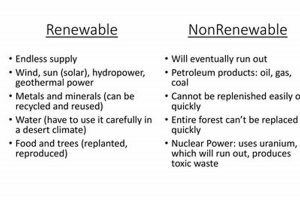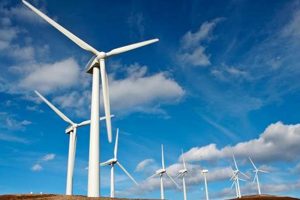Wind power presents several compelling reasons for its adoption as an energy source when compared to other renewable alternatives. These merits encompass factors such as land use efficiency, cost-effectiveness, scalability, and its potential for integration into existing energy grids. A critical assessment reveals a complex interplay of environmental, economic, and technological considerations that position wind energy favorably in specific contexts.
The significance of harnessing wind’s kinetic energy lies in its capacity to diversify energy portfolios, reduce reliance on finite fossil fuels, and mitigate the impact of greenhouse gas emissions. Historically, wind energy technologies have evolved substantially, leading to enhanced turbine designs and improved energy capture rates. This ongoing development fosters further investment and deployment, driving down costs and boosting its overall competitiveness within the renewable energy landscape.
The ensuing discussion will explore specific areas where this energy source excels, including its lower operational costs, minimal water consumption, and its capacity for co-location with agricultural activities. The advantages in these areas will be directly contrasted with those of other renewable energy sources such as solar, geothermal, and hydroelectric power, providing a detailed understanding of its unique contributions to sustainable energy production.
Optimizing Wind Energy Integration
The following recommendations offer insights into maximizing the benefits of wind energy in comparison to alternative renewable sources. These guidelines address factors such as resource assessment, grid integration, and long-term investment strategies.
Tip 1: Conduct Comprehensive Resource Assessments: Accurately evaluate wind resource potential at prospective sites. Detailed wind data collection and analysis are crucial for optimizing turbine placement and predicting energy yields. Ignoring these aspects can lead to significant underperformance when compared to other renewable installations with more predictable output, such as geothermal.
Tip 2: Prioritize Grid Integration Planning: Develop robust grid integration plans to accommodate the variable nature of wind energy. Employ advanced forecasting techniques and energy storage solutions to ensure grid stability. In contrast to some other renewable sources that offer more consistent power supply, wind power necessitates proactive grid management.
Tip 3: Implement Efficient Maintenance Strategies: Establish proactive maintenance schedules to minimize downtime and maximize turbine lifespan. Regular inspections and timely repairs are essential for ensuring optimal performance and reducing operational costs over the project lifecycle. Compared to geothermal or hydroelectric, wind turbines require more frequent physical intervention.
Tip 4: Explore Hybrid Renewable Energy Systems: Consider combining wind energy with other renewable sources, such as solar, to create hybrid systems that offer a more reliable and balanced energy supply. This approach can mitigate the intermittency of wind power and enhance overall system efficiency. This is an advantage over relying solely on a geographically limited resource.
Tip 5: Secure Long-Term Power Purchase Agreements: Establish long-term power purchase agreements (PPAs) to provide revenue certainty and attract investment in wind energy projects. Stable revenue streams are critical for securing financing and ensuring the long-term viability of wind farms. Demonstrating predictable cash flows can make wind investments more appealing than those in less proven renewable technologies.
Tip 6: Invest in Advanced Turbine Technologies: Focus on deploying advanced turbine technologies that offer higher efficiency, lower noise levels, and improved reliability. Innovations in turbine design and materials are continuously improving the performance and cost-effectiveness of wind energy. Embracing technological advancements can allow wind to become more competitive than other renewables.
Tip 7: Consider Colocation Opportunities: Explore the possibilities of colocating wind farms with agricultural activities or other land uses to maximize land use efficiency and minimize environmental impacts. This allows wind farms to occupy larger areas more effectively when compared to other renewable projects which require total use of land.
Adhering to these recommendations enables stakeholders to optimize the integration and utilization of wind, capitalizing on its comparative strengths within the wider landscape of renewable energy options. Such strategies are vital for advancing sustainable energy goals and minimizing environmental impact.
The following sections will elaborate further on specific aspects of wind energy project development and operational optimization, providing a more comprehensive perspective on maximizing its potential.
1. Scalability and Deployment
The capacity for rapid scaling and widespread deployment represents a critical advantage of wind energy within the renewable energy sector. This characteristic significantly influences its ability to address global energy demands and facilitates integration into existing energy infrastructure.
- Modular Design and Construction
Wind turbines are inherently modular, facilitating phased development and expansion. This allows for incremental capacity increases, adapting to fluctuating energy needs and optimizing capital investment. Unlike hydroelectric projects that require large-scale, long-term construction, wind farms can be constructed relatively quickly.
- Wider Geographic Applicability
Wind resources are distributed across numerous regions, enabling decentralized energy production. This reduces transmission losses and enhances energy security by diversifying energy sources. This contrasts with geothermal energy, which is restricted to areas with specific geological features.
- Offshore Development Potential
Offshore wind farms offer the opportunity for large-scale energy generation in areas with strong and consistent wind resources. These locations often experience less visual impact and can be situated closer to major population centers. This advantage contrasts with solar farms, which can face land-use constraints.
- Reduced Lead Times
The relatively short lead times for wind farm construction, compared to nuclear or large hydroelectric projects, allow for a quicker response to increasing energy demand. This accelerates the transition to renewable energy sources and supports decarbonization efforts.
These factors, related to scalability and deployment, collectively contribute to the viability of wind energy as a primary component of a sustainable energy future. The ability to rapidly deploy and expand wind energy capacity, combined with its widespread availability, positions it favorably compared to other renewable alternatives.
2. Land Use Efficiency
Wind energy exhibits a distinct advantage in land use efficiency compared to several other renewable energy sources. The operational footprint of a wind farm, referring to the actual area occupied by turbines, constitutes only a small fraction of the total land area. This characteristic allows for compatible land uses, such as agriculture or grazing, to continue concurrently, maximizing the productivity of the land. The effect of this optimized land usage is a reduction in potential conflicts over resource allocation and a greater overall sustainability profile for the energy generation project.
Consider, for instance, the comparison with large-scale solar photovoltaic (PV) installations. While solar farms generate substantial electricity, they necessitate the complete clearing of vegetation across the designated area, precluding most alternative land uses. Conversely, the space between wind turbines can readily accommodate crops or livestock, yielding both energy and agricultural outputs. Geothermal energy, while also efficient, often requires significant subsurface infrastructure that may restrict certain surface activities. The importance of land use efficiency becomes particularly salient in regions with limited available land or a high demand for agricultural production.
In summary, the reduced physical footprint of wind farms and the ability to co-locate with other productive land uses underscore the advantages of wind energy in terms of land use efficiency. This attribute minimizes environmental impact, supports rural economies through diversified income streams, and facilitates the integration of renewable energy projects into existing landscapes with minimal disruption. The practical significance of this understanding lies in the potential for optimizing resource utilization and achieving a more sustainable and harmonious coexistence between energy production and other societal needs.
3. Lower Operational Costs
Wind energy exhibits lower operational costs primarily because it relies on a free and inexhaustible energy source: wind. Once a wind farm is constructed, the expenses associated with fuel acquisition and combustion, which are significant in fossil fuel-based power plants and biomass energy facilities, are entirely eliminated. These savings contribute significantly to the overall economic advantage of wind energy compared to many renewable alternatives. For instance, geothermal plants, while also benefiting from a natural resource, incur costs related to maintaining wells and managing potential geological instability. Concentrated solar power requires ongoing expenditures for mirror maintenance and heat transfer fluids, adding to operational expenses. The absence of these costs makes wind power an economically attractive option.
Furthermore, wind turbine technology has advanced to the point where maintenance intervals are relatively long, and automated monitoring systems can detect potential issues before they escalate into costly repairs. This proactive approach minimizes downtime and optimizes energy production, further reducing operational expenditures. The modular nature of wind farms also allows for phased maintenance, where turbines can be serviced individually without disrupting the entire facility’s output. This contrasts with hydroelectric dams, where major repairs necessitate complete shutdowns and substantial financial outlays. A practical example is the Hornsea Wind Farm in the UK, which uses advanced remote monitoring systems to reduce the need for physical inspections, driving down maintenance costs significantly.
In conclusion, the combination of free fuel, technological advancements, and efficient maintenance practices leads to significantly lower operational costs for wind energy compared to many other renewable alternatives. This economic advantage, coupled with its environmental benefits, positions wind power as a key component of a sustainable energy future. While challenges remain in areas like grid integration and energy storage, the cost savings associated with wind energy operations make it an increasingly competitive and attractive investment for both public and private sectors.
4. Technological Maturity
The technological maturity of wind energy systems represents a pivotal component within its spectrum of advantages when juxtaposed with other renewable energy sources. This maturity translates into tangible benefits stemming from decades of research, development, and deployment across diverse geographical environments. The evolution of wind turbine technology has yielded significant improvements in energy capture efficiency, reliability, and operational lifespan, placing wind energy in a comparatively advanced position relative to nascent technologies like advanced geothermal systems or certain biomass conversion methods. The consequence of this technological development is a reduction in energy production costs, making wind energy an increasingly competitive alternative to traditional fossil fuels and less established renewable options.
The widespread deployment of wind energy has fostered a robust supply chain and a skilled workforce capable of manufacturing, installing, and maintaining wind turbines. This established infrastructure contributes to the reduction of project risks and fosters investor confidence, leading to further investment and innovation. In contrast, some renewable energy technologies, despite promising potential, still grapple with scaling challenges and lack the mature supply chains necessary for widespread adoption. For instance, wave energy converters, while harnessing a vast resource, are still in the early stages of commercialization and face technological hurdles in terms of durability and energy capture optimization. The accumulated knowledge and practical experience within the wind energy sector offer a demonstrable advantage in terms of project execution and long-term operational performance, thereby mitigating risks associated with less mature technologies.
In summary, the technological maturity of wind energy provides a significant advantage through increased efficiency, reduced costs, established infrastructure, and a skilled workforce. This maturity not only enhances its competitiveness in the renewable energy market but also contributes to its reliability and sustainability, facilitating a more rapid and effective transition toward a decarbonized energy system. Despite ongoing research and development in other renewable energy fields, wind energy’s current level of technological advancement positions it as a readily deployable and economically viable solution for addressing global energy demands and mitigating climate change.
5. Global Resource Abundance
Global resource abundance, particularly the ubiquitous nature of wind, stands as a foundational advantage distinguishing wind energy from many other renewable energy sources. Its broad geographic distribution directly impacts the feasibility and accessibility of deploying wind energy systems on a global scale, influencing both the cost-effectiveness and scalability of this renewable option. Understanding the nuances of this global resource abundance is essential for fully appreciating the potential and limitations of wind energy within the broader renewable energy landscape.
- Widespread Geographic Potential
Wind resources are not confined to specific geological formations or climates, unlike geothermal or concentrated solar power, which necessitate particular environmental conditions. Wind energy potential exists across diverse regions worldwide, from coastal areas and plains to mountainous regions, allowing for localized energy production and reduced transmission costs. For example, regions lacking geothermal activity can still harness wind power, diversifying their energy portfolio and enhancing energy security.
- Offshore Wind Resources
Offshore wind resources offer a particularly compelling advantage due to their strength and consistency. Coastal regions often experience higher average wind speeds than land-based sites, leading to greater energy production. Offshore wind farms also minimize visual impact and reduce land use conflicts. Countries with limited land area can leverage offshore wind resources to significantly increase their renewable energy capacity, a benefit not readily available with land-intensive renewable options like biomass or large-scale solar farms.
- Reduced Dependence on Specific Locations
The wide distribution of wind resources mitigates the risk of reliance on a small number of resource-rich areas. Countries can develop wind energy projects within their own borders, reducing dependence on energy imports and enhancing energy independence. This contrasts with hydroelectric power, which is contingent on the availability of suitable river systems and can lead to geopolitical tensions over water resources.
- Adaptability to Various Climates
Modern wind turbine technology has been engineered to withstand a wide range of climatic conditions, from extreme cold to tropical storms. This adaptability allows wind energy systems to operate reliably in diverse environments, expanding their potential deployment areas. While some renewable sources, such as solar, may be less effective in cloudy or snowy climates, wind energy can continue to generate power even under such conditions, provided wind speeds are sufficient.
The widespread availability of wind resources provides a strategic advantage by enabling countries to diversify their energy mix, reduce dependence on fossil fuels, and enhance energy security. The global reach of this resource, coupled with the ongoing technological advancements in turbine design and grid integration, solidifies wind energy’s role as a central pillar in the transition towards a sustainable and resilient global energy system. The contrast with geographically constrained renewable options underscores the significance of wind’s ubiquitous presence and its potential to contribute to energy security and environmental sustainability worldwide.
Frequently Asked Questions
The subsequent section addresses recurring inquiries concerning the benefits of wind energy in comparison to alternative renewable energy sources. These responses aim to provide clarity and factual information on key aspects of wind energy technology and its practical implementation.
Question 1: How does wind energy’s land use compare to solar photovoltaic (PV) farms?
Wind farms frequently allow for concurrent land uses such as agriculture, whereas large-scale solar PV installations typically necessitate complete vegetation removal across the project area, restricting alternative land utilization.
Question 2: What contributes to wind energy’s lower operational costs compared to biomass?
Wind energy’s operational expenses are reduced due to the absence of fuel costs, a significant factor in biomass energy, which requires the continuous procurement and processing of organic matter.
Question 3: How does the geographical availability of wind energy compare to geothermal energy?
Wind resources are globally distributed, enabling wider deployment compared to geothermal energy, which is constrained by specific geological requirements that limit its application to certain regions.
Question 4: In what ways has wind turbine technology improved in recent years?
Advancements in wind turbine design have resulted in higher energy capture efficiency, enhanced reliability, and extended operational lifespans, making wind energy more competitive and sustainable.
Question 5: How does the scalability of wind energy projects compare to hydroelectric dams?
Wind energy projects possess greater scalability due to their modular construction, allowing for phased development and expansion, unlike hydroelectric dams, which demand substantial upfront investment and long construction periods.
Question 6: What role does offshore wind energy play in global energy security?
Offshore wind energy taps into strong and consistent wind resources, especially in coastal areas. It is not reliant on land area. This reduces land use conflicts and increases capacity for energy production.
In summary, wind energy presents unique advantages in land use, operational costs, resource availability, technological maturity, and scalability. These factors collectively position it as a pivotal component of a diversified and sustainable energy future.
The following section will elaborate on the challenges and considerations related to integrating wind energy into existing power grids, addressing issues such as intermittency and grid stability.
Advantages of Wind Energy Over Other Renewable Energy
The preceding analysis has elucidated various factors that establish specific benefits inherent to wind energy when contrasted with alternative renewable sources. These encompass scalability, land use efficiency, operational costs, technological maturity, and resource availability. It is evident that the capacity for broad geographic deployment, alongside co-location opportunities and a comparatively low operational overhead, positions wind as a strategically valuable asset within a diversified energy portfolio.
The sustained advancement of wind turbine technology, coupled with ongoing refinement of grid integration strategies, will likely solidify its role in meeting escalating global energy demands. Continued investment in research and development, alongside informed policy decisions, are essential to realizing the full potential of wind energy as a cornerstone of a sustainable and resilient energy infrastructure. Its impact on our energy future is crucial and requires a deep understanding of its advantages and how to harness them effectively.





![[Wind Energy] Why IS Wind Renewable? Source Explained! Renewable Energy Solutions for a Sustainable Future | Clean & Green Power [Wind Energy] Why IS Wind Renewable? Source Explained! | Renewable Energy Solutions for a Sustainable Future | Clean & Green Power](https://pplrenewableenergy.com/wp-content/uploads/2025/09/th-873-300x200.jpg)

